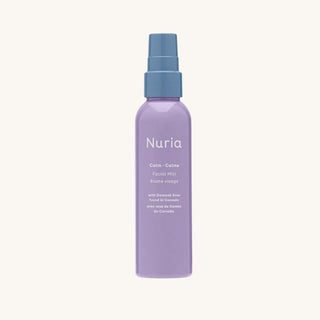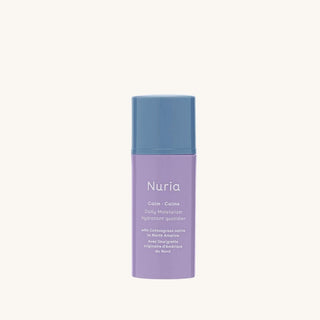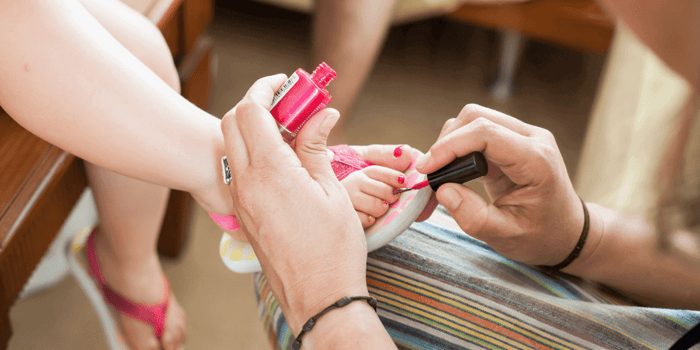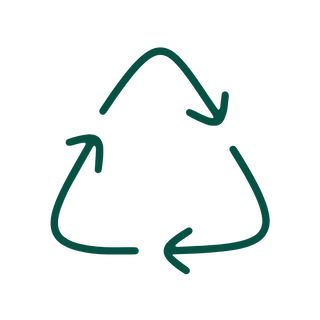What To Expect In This Blog Post
🔷 Introduction: The Hidden Dangers in Kids’ Nail Polish
- Many kids' nail polishes claim to be non-toxic, but some still contain harmful chemicals.
- Common concerns: skin irritation, hormone disruption, and long-term health risks.
- This guide will expose toxic ingredients and help parents choose truly safe, non-toxic alternatives.
🟣 Section 1: The Worst Ingredients in Nail Polish & Their Health Risks
1.1 The Toxic Trio: Formaldehyde, Toluene & Dibutyl Phthalate (DBP)
- Formaldehyde – A known carcinogen that helps harden polish but can cause breathing issues and skin irritation.
- Toluene – A solvent linked to dizziness, nausea, and nervous system damage.
- Dibutyl Phthalate (DBP) – A plasticizer banned in the EU but still found in some U.S. products, linked to hormone disruption.
1.2 Other Hidden Chemicals to Watch Out For
- Camphor – Can cause dizziness, nausea, and liver toxicity in large amounts.
- Parabens – Used as preservatives but can interfere with hormonal development.
- Triphenyl Phosphate (TPHP) – A chemical that can disrupt hormone function and reproductive health.
- Synthetic Fragrances & Dyes – May contain undisclosed ingredients, including potential skin irritants and allergens.
🟡 Section 2: The Truth About “Free-From” Labels (5-Free, 7-Free, 10-Free, etc.)
- What do “5-Free,” “7-Free,” and “10-Free” actually mean? (Breakdown of common claims).
- Are brands using these labels as a marketing gimmick? Some still contain harmful ingredients not included in the “free-from” list.
- How to read ingredient lists carefully and verify claims with third-party certifications.
🟢 Section 3: How to Choose a Truly Non-Toxic Nail Polish for Kids
- Look for water-based, plant-based, or breathable formulas instead of traditional solvent-based polishes.
- Check for certifications like EWG Verified™, Made Safe®, or USDA BioPreferred.
- Opt for brands that disclose their full ingredient list and don’t rely solely on “free-from” marketing.
- Choose odor-free or lightly scented options to avoid hidden synthetic fragrances.
🔵 Section 4: Best Non-Toxic Nail Polish Brands for Kids
- Plant-based options – Derived from natural ingredients like corn, potatoes, or sugarcane.
- Water-based polishes – Easily peel off without toxic removers.
- Breathable formulas – Allow moisture and oxygen to pass through for healthier nails.
- Examples of truly non-toxic brands (list safe, clean options).
🟠 Section 5: Nail Polish Removers – Are They Safe?
- Many removers contain acetone or ethyl acetate, which can dry out nails and irritate the skin.
- Best non-toxic alternatives – Soy-based, water-based, and biodegradable removers.
- Tips for safe nail polish removal for kids.
🔷 Conclusion: Making Safer Choices for Your Child’s Nails
- Not all “non-toxic” nail polishes are truly safe—learning to read labels and avoid misleading marketing is key.
- Choosing water-based, plant-based, and free-from formulas reduces toxic exposure while keeping nail time fun.
- Prioritize brands with full transparency and third-party safety certifications.
- Take action: Check your child’s nail polish ingredients today and switch to a safer, healthier option!
🔷 Introduction: The Hidden Dangers in Kids’ Nail Polish
Many parents assume that nail polish designed for kids is automatically safe and non-toxic, but that’s not always the case. While some brands use clever marketing terms like "kid-friendly," "non-toxic," or "natural," their formulas may still contain harmful chemicals linked to skin irritation, hormone disruption, and even long-term health risks. Ingredients like formaldehyde, toluene, and phthalates (DBP)—commonly found in conventional nail polish—are known to cause breathing issues, allergic reactions, and endocrine interference, yet they still sneak into many products sold for children.
Even brands that claim to be "5-Free," "7-Free," or "10-Free" may not be as safe as they seem. While these labels suggest that certain toxic ingredients have been removed, they don’t guarantee a completely clean formula. Parents looking for truly non-toxic nail polish need to go beyond the labels and understand what’s actually in the bottle.
In this guide, we’ll break down the most harmful chemicals in kids’ nail polish, expose the truth about “free-from” claims, and provide safe, non-toxic alternatives so your child can enjoy fun, colorful nails without toxic exposure. Let’s dive into what you need to know to make better, healthier beauty choices for your little one.
🟣 Section 1: The Worst Ingredients in Nail Polish & Their Health Risks
When shopping for kids’ nail polish, many parents focus on fun colors and cute packaging, assuming the ingredients inside are safe. However, traditional nail polishes often contain a cocktail of harsh chemicals that can pose serious health risks, especially for young children who frequently put their hands in their mouths. Some of the most concerning ingredients include formaldehyde, toluene, and dibutyl phthalate (DBP)—commonly known as the “Toxic Trio.”
Formaldehyde, a well-known carcinogen, is used to harden nail polish and prevent chipping, but it emits strong fumes that can irritate the eyes, nose, and throat. Long-term exposure has been linked to respiratory issues and allergic skin reactions. Toluene, another key ingredient in traditional nail polish, is a solvent that helps create a smooth application, but it has been associated with dizziness, headaches, and even nervous system damage with repeated exposure. Dibutyl Phthalate (DBP), once common in mainstream polishes, is now banned in the European Union due to its links to hormone disruption, reproductive toxicity, and developmental issues—yet it still appears in some U.S. nail products.
Beyond the Toxic Trio, other concerning chemicals lurk in many polishes. Camphor can cause nausea and skin irritation, while Triphenyl Phosphate (TPHP), a chemical used to improve polish flexibility, has been linked to endocrine disruption and potential developmental harm. Even seemingly harmless additions like synthetic fragrances and artificial dyes may contain undisclosed ingredients, including allergenic compounds and petroleum-based colorants.
Because young children’s bodies are more sensitive to toxins, prolonged exposure to these chemicals—even in small amounts—can have lasting effects. That’s why it’s crucial for parents to know what’s in their child’s nail polish and opt for truly non-toxic alternatives that eliminate these harmful substances altogether.
🟡 Section 2: The Truth About “Free-From” Labels – Are They Actually Safer?
Many parents looking for safer nail polish options are drawn to “5-Free,” “7-Free,” or “10-Free” labels, assuming these formulas are completely non-toxic. While these labels do indicate the absence of certain harmful chemicals, they don’t always mean a product is truly safe, natural, or non-toxic. The “free-from” system was created as a response to growing consumer awareness, but it’s not regulated by any governing body, which means brands can use these claims without strict oversight.
So, what do these numbers actually mean? A “5-Free” polish typically removes the Toxic Trio—formaldehyde, toluene, and dibutyl phthalate (DBP)—plus formaldehyde resin and camphor. “7-Free” goes a step further by eliminating ethyl tosylamide and xylene, which have been linked to allergic reactions and nervous system toxicity. “10-Free” expands on this by removing triphenyl phosphate (TPHP), parabens, and synthetic fragrances, but some brands still sneak in other questionable ingredients under vague terms like "proprietary blend" or "fragrance."
The problem is that even a “10-Free” formula doesn’t necessarily mean it’s truly non-toxic or kid-safe. Some brands simply swap one harmful chemical for another—for example, replacing DBP with another plasticizer that has unknown long-term effects. Additionally, some water-based formulas marketed as "odor-free" or "natural" still contain acrylic polymers and synthetic stabilizers, which are not always disclosed on the label.
To ensure a polish is truly non-toxic, parents should look beyond the marketing claims and check for full ingredient transparency. The safest options are those that fully disclose their formula, use plant-based or water-based ingredients, and hold third-party safety certifications like EWG Verified™, Made Safe®, or USDA BioPreferred. Simply choosing a polish based on “free-from” claims alone isn’t enough—understanding what’s actually inside the bottle is the best way to protect kids from hidden toxins.
🟢 Section 3: How to Choose a Truly Non-Toxic Nail Polish for Kids
With so many misleading labels and hidden toxins in kids' nail polish, how can parents be sure they’re choosing a truly safe, non-toxic option? The key is to go beyond "free-from" claims and look for ingredient transparency, safer formulations, and third-party certifications that verify a brand’s commitment to clean beauty.
One of the best choices for children’s nail polish is water-based formulas, which eliminate the need for harsh solvents like toluene or ethyl acetate. Unlike conventional polishes, water-based options dry through evaporation instead of chemical reactions, making them low-odor, breathable, and gentler on nails. Another safe alternative is plant-based nail polish, which replaces petroleum-derived ingredients with corn, sugarcane, or potato-based solvents to create a polish that is biodegradable and free from endocrine disruptors.
Parents should also look for full ingredient disclosure—if a brand doesn’t list every ingredient, it’s a red flag. Additionally, choosing polishes with third-party safety certifications like EWG Verified™, Made Safe®, or USDA BioPreferred ensures the product has been independently tested for toxicity and environmental safety.
Another important consideration is odor and ease of removal. Many solvent-based nail polishes have strong fumes that contain volatile organic compounds (VOCs), which can cause headaches and respiratory irritation, especially in enclosed spaces. Opting for low-odor, solvent-free formulas minimizes exposure to unnecessary chemicals. When it’s time to remove the polish, soy-based or acetone-free removers are much safer alternatives to traditional nail polish removers, which often contain harsh drying agents.
Ultimately, the safest kids’ nail polish brands will be transparent about their ingredients, avoid synthetic plasticizers and toxic solvents, and prioritize breathable, water-based, or plant-based alternatives. By making informed choices, parents can ensure that their child’s nail polish is fun, vibrant, and completely safe for little hands.
🔵 Section 4: Best Non-Toxic Nail Polish Brands for Kids
With so many brands marketing their nail polishes as "non-toxic" and "safe for kids," it can be difficult to separate truly clean formulas from those that simply use clever marketing. While many brands eliminate the "Toxic Trio" (formaldehyde, toluene, and DBP), some still include synthetic dyes and pigments derived from petroleum-based FD&C colors—which have been linked to skin irritation, allergies, and even potential toxicity when ingested.
One of the few truly clean nail polish brands for kids is No Nasties, which stands out by avoiding FD&C dyes and synthetic pigments entirely. Instead of using petroleum-derived colorants, No Nasties utilizes natural, mineral-based pigments, making it one of the safest options for parents concerned about hidden toxins in kids' nail polish. Their formulas are also water-based, odor-free, and free from synthetic plasticizers, ensuring a gentle, breathable experience for young nails.
Other brands, such as Ella + Mila, Piggy Paint, and Nailmatic, claim to be non-toxic, but their formulas still contain FD&C dyes—which are commonly found in conventional nail polish and have been linked to allergic reactions, skin sensitivity, and possible hormone disruption. While these brands are often free from major toxins like formaldehyde and phthalates, they still rely on synthetic colorants and plastic-based resins to achieve bright, long-lasting colors.
For parents looking for a truly clean and kid-safe alternative, it’s essential to read ingredient lists carefully and not rely on marketing claims alone. A good rule of thumb is to look for:
✅ Full ingredient transparency (no vague terms like "colorants" or "proprietary blends").
✅ Plant-based, water-based, or mineral pigment alternatives instead of synthetic FD&C dyes.
✅ Breathable, non-toxic formulas that don’t rely on plastic-derived film-forming agents.
At the end of the day, not all "non-toxic" nail polishes are created equal. Brands like No Nasties provide a truly clean, chemical-free option, while other brands still contain questionable ingredients despite their safer claims. Parents should always check ingredient labels, certifications, and product formulations to ensure their child's nail polish is as safe as it claims to be.
🟠 Section 5: Nail Polish Removers – Are They Safe?
Choosing a non-toxic nail polish is only half the battle—many traditional nail polish removers contain harsh, drying chemicals that can be just as harmful as the polish itself. The most common ingredient in conventional removers is acetone, a powerful solvent that quickly dissolves polish but also strips moisture from nails and skin, leaving them brittle and prone to peeling. Acetone exposure can also cause headaches, dizziness, and respiratory irritation, making it a poor choice for young children.
Even some "non-acetone" removers aren’t entirely safe, as they often contain ethyl acetate or isopropyl alcohol, which can still cause skin irritation and dryness. Some brands may also include artificial fragrances or preservatives, which can introduce hidden endocrine-disrupting chemicals that aren't always disclosed on ingredient lists.
A safer alternative is soy-based or plant-derived nail polish removers, which work by softening polish instead of dissolving it instantly. These removers are often enriched with natural oils like soybean or coconut oil, helping to nourish and strengthen nails while breaking down polish gently. Water-based nail polishes often don’t require harsh removers at all, as they can be peeled off or removed with just warm water and mild soap.
When selecting a kid-friendly nail polish remover, parents should look for:
✅ Soy-based or biodegradable formulas that avoid acetone and ethyl acetate.
✅ Fragrance-free options to reduce exposure to synthetic scent chemicals.
✅ Nail conditioners (like aloe vera or vitamin E) that prevent drying and irritation.
While removing nail polish might seem like a small part of a beauty routine, using a harsh chemical remover regularly can lead to long-term damage to young nails and cuticles. By choosing non-toxic alternatives, parents can ensure that every step of their child’s nail care routine is as safe and gentle as possible.
🔷 Conclusion: Making Safer Choices for Your Child’s Nails
When it comes to kids' nail polish, not all "non-toxic" claims are created equal. While many brands remove the most well-known toxic chemicals, they may still contain questionable ingredients like FD&C dyes, synthetic plasticizers, and harsh solvents. Understanding what’s truly in your child’s nail polish—and their remover—is essential to ensuring their safety and minimizing exposure to harmful chemicals.
The best way to make safer choices is to go beyond marketing labels and look for brands with full ingredient transparency, plant-based or water-based formulas, and independent safety certifications. Brands like No Nasties, which avoid synthetic dyes and plastic-derived film-forming agents, offer a truly clean alternative for young children. Likewise, soy-based or biodegradable nail polish removers help prevent nail damage and unnecessary chemical exposure.
By choosing truly non-toxic nail products, parents can create a fun, colorful, and worry-free beauty experience for their children. A little extra research goes a long way in ensuring that playtime stays safe—so always check labels, question marketing claims, and opt for brands that prioritize both safety and sustainability.
Want to explore more about safe nail polish and toxin-free manicures for kids? Check out Safe & Non-Toxic Nail Care for Kids to learn about the best brands, safe removal methods, and fun, non-toxic nail art ideas.
